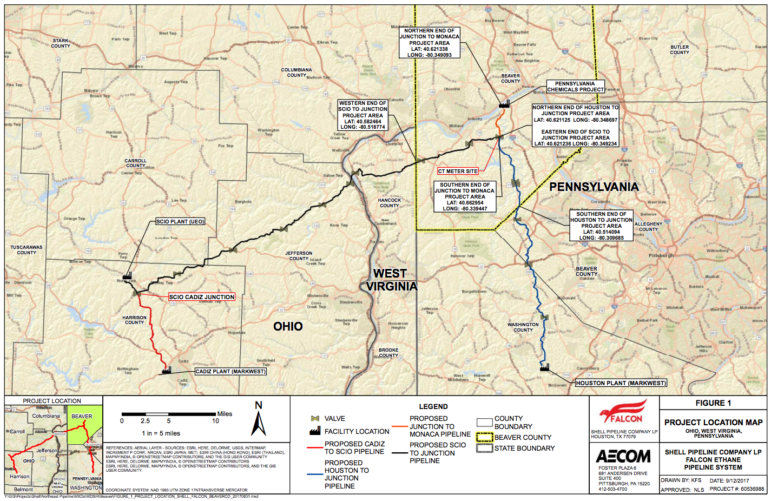In late 2017, Shell Pipeline Company filed a 20,000 page application for permits to construct the 45-mile Falcon Ethane Pipeline —and that’s just for its route through Pennsylvania. But don’t be fooled by the huge volume of information: this plan falls far short of fully accounting for the pipeline’s potential impacts.
To its credit, the Pennsylvania Department of Environmental Protection (DEP) agreed–pointing out 101 “significant technical deficiencies” in Shell’s application. Many of these echo formal comments from Earthworks, partners, and residents. These include:
- Unaddressed interference with the Montour Trail, used by over 400,000 people annually.
- A completely absent emergency plan for a pipeline carrying a highly explosive substance that could harm communities, schools, day cares, parks, and major water supplies like the Ambridge Reservoir—nor any measures to notify residents when spills or other accidents and damage occur.
- Shell would use horizontal directional drilling (HDD)—an intensive construction method with serious risks to water quality and major air emissions—18 times along the Falcon’s route through fragile karst topography. Yet, the company doesn’t have a plan for mitigating or managing sinkholes and landslides like the kind created by ETP’s Mariner East 2 pipeline.
- An inability to meet local zoning ordinances or obtain local approvals in at least one county it would cross.
Short of deliberate obfuscation by Shell, it’s possible that the long list of missing facts and information reflects a project that simply cannot be adequately and safely overseen. Given this, it’s even more alarming that even while still grappling with the deficiencies DEP already identified in the application for land and water permits, on June 20th Shell requested to be exempted from the standard process of getting a permit to emit air pollution from a pipeline metering station along the Falcon.
The Falcon ethane pipeline comes with notable risks to the region’s air quality. Ethane—which the pipeline would transport—is a greenhouse gas, and could leak from the nine valves and four metering stations along the pipeline. Optical gas imaging (OGI) footage collected by Earthworks demonstrates the potential for leaks at metering stations and pipeline valves.
Ethane combines with sunlight to form ground-level ozone. This ozone causes respiratory symptoms and can trigger asthma attacks, as explored in Country Living, Dirty Air: Oil & Gas Pollution in Rural America, a recent report by Earthworks and Clean Air Task Force. The Falcon would continuously release pollution from processing facilities, which would compress and pump the ethane across three counties. In addition, local air quality would be impacted by dust, volatile organic compounds, and other pollutants resulting from construction and HDD activities.
None of these emissions were included in the emissions reductions credits (ERCs) for Shell’s ethane cracking facility itself—without which that facility couldn’t have been built because of air quality impacts. Shell has effectively treated a significant pipeline proposal essential to the operation of the cracker plant as if it’s an afterthought.
But the Falcon is tied to an impending increase in production at nearby gas wells and expansion of operations at compressor facilities, processing plants, and other “natural” gas infrastructure—something that Shell, DEP, and policymakers must have foreseen during the many years of planning and permitting for the Shell cracker plant. The air pollution that comes with this production is irrefutable; Earthworks partners with impacted residents to collect visible proof of existing gas pollution all over the state.
Now, the public is being denied any opportunity to consider these cumulative impacts to the region’s already awful air quality. The three counties in the pipeline’s route have ozone levels right at 70 ppm or hovering just below—barely within attainment of the EPA’s 2015 National Ambient Air Quality Standards.
So far, Shell has only applied for air exemptions on one metering station of four. We still don’t know what the other stations will emit. We also await word of how a recent settlement agreement between the DEP and environmental groups on the ME2 pipeline could alter the outcome of Shell’s pending applications.
In the technical deficiency letters issued to Shell, DEP has wisely commanded the company to declare a plan to mitigate cumulative impacts to wetlands created by this and other planned and existing projects in the area. DEP should extend this same logic to air quality, and recognize that Shell is taking advantage of piecemeal permitting to obscure its plans to pollute. To protect air quality, human health, and the climate, DEP should deny Shell’s every attempt to skirt a full accounting of this project’s dangerous air pollution.

